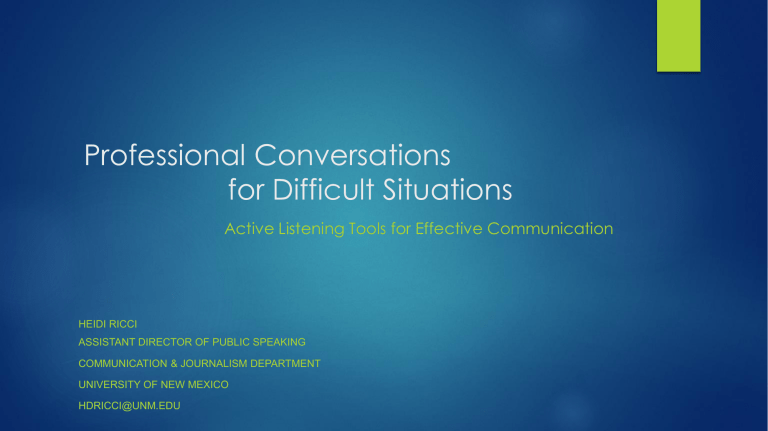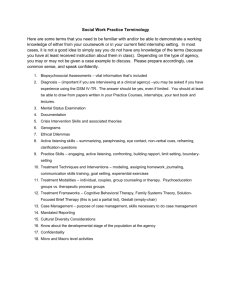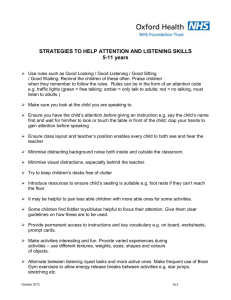power point presentation

Professional Conversations for Difficult Situations
Active Listening Tools for Effective Communication
HEIDI RICCI
ASSISTANT DIRECTOR OF PUBLIC SPEAKING
COMMUNICATION & JOURNALISM DEPARTMENT
UNIVERSITY OF NEW MEXICO
HDRICCI@UNM.EDU
“ IT’S NOT WHETHER YOU HAVE CONFLICT
IN YOUR LIFE, BUT HOW YOU DEAL WITH
CONFLICT THAT MAKES A DIFFERENCE “in the potential outcome ”
BY: THOMAS CRUMM
THE MAGIC OF CONFLICT
Word or words come to mind when I say Conflict?
What is Conflict?
Unmet Expectations
Negative Assumptions
Passive Listening: Little/No feed back or unhelpful “feedback”
Ex: “Yea, I heard you….”
Defensive Listening: Trying to think of next thing to say…leads to:
Circular Causation: The creation of a cycle in which we automatically react to a word, phrase, a look or body language from a person who knows how to “push our buttons”. It perpetuates negative reinforcement
Have You Considered…
There is positive side of Conflict: It forces us to address an issue or make a needed change – (what is definition of insanity?)
In our behavior
In our approach
Think Oyster!
But in order that to happen we need to:
Be open to change our approach to difficult conversations with challenging person(s) so you can obtain both what you want And what you need!
How are your Listening Skills?
Fill out assessment and lets see….
Active Listening
People want to be Heard!
Active listening is:
Being attentive and respectful to the person talking.
Active Listening is not: planning your response to what the person is saying. day dreaming or checking your phone while they are talking.
It is not solving their problems or giving advice
( however, active listening can help you problem solve and move a difficult conversation forward )
Active Listening is Non-Verbal
Communication:
Body language
Eye Contact
Facial expression
Head nods
Your body language, eye contact, and nonverbal communication speak as loudly as you what you say!
Nonverbal video:
ACTIVE LISTENING
THE THREE R’S
STEP 1: LEARN (and Practice) THE 3 R’S
Reflect
Rephrase
Reframe
Being able to do these things is not about agreement. It is about showing someone you have heard what they said. This is a first step to potentially finding a positive outcome.
REFLECT
Reflecting is also called Mirroring: Stating back to someone exactly what they said, how they said it.
Rephrase:
Saying the same thing …just a little differently
Rephrasing (or paraphrasing) lets a person know that he or she has been heard and correctly understood by the listener. It is used to prevent misunderstandings.
For the speaker: rephrasing reinforces your expectation others are actually listening to what you have to say, while providing you the opportunity to clarify your intent.
For the listener: rephrasing validates what you have heard by checking your understanding, either reinforcing it or modifying it based on the speaker’s clarification.
Rephrasing defuses "loaded" terms or by showing an understanding and validation of the (often negative) emotions behind the statement and reframes the statement in a more positive light
Rephrase Examples
Turning negatives to positives and ….
validating someone has been heard & understood
Everyone was against me! - "Sounds like you felt attacked."
Jim’s an idiot! - “What Jim said seems to have made you angry.”
No one ever gives me credit ! "So you felt ignored or unappreciated."
“You were upset when ...”
"You believe that..." “You seem to be saying...”
“If I understand you correctly, you want...”
"You seem to be concerned that...“
"What seems most important to you is...”
Reframe
Reframing is being able to take the other persons ideas, feelings, facts, or concerns and reframe them into a single common focus theme (which they themselves may not have even realized.)
Being able to do this can move the conversation in a more constructive direction.
Reframe
Reframing is being able to take one some one is saying and put a different spin on it, rather than focus on what didn’t work or the negative. Reframing can be used as springboard or transition into creative ideas, options, solutions and commitment for future joint initiatives
Example:
“I hear a few concerns and some idea’s…is it fair to say based on what you’ve said so far, it is important to you to find new ways for labor and management to work together?"
Active Listening –
“Moving through the difficult conversation”
STEP 2:
Find Common Ground: (You do this through the 3R’s)
Separates the people from the problem ( you don’t necessarily have to like the person to resolve the problem !)
Helps you see each other as people and not a problem!
See video: Wedding Crashers
Wedding Crashers Mediation Scene
How we “see” each other when we are in conflict
Active Listening helps with Hearing &
Understanding the “Need”
POSITIONS: are the “bottom line” line demands present in conflict.
They are the “non-negotiable” demands a party makes.
.
INTERESTS and NEEDS: are the basic human needs, concerns, and values that motivate every person. Through Active listening you are better able to discover the needs! (This can also happen when you see others as people and not problem)
One of the most important skills in moving through a negotiation or difficult conversation is to recognize the underlying needs and interests because Needs are more negotiable than positions.
Active Listening Can Help You…
STEP 3:
Be aware of your nonverbal communication
Put the 3 R’s into practice
Find common ground
Separate people from problem
Active Listening Skills aren’t difficult concepts…but they are also not necessarily natural skills. But active listening can be the tool that helps you obtain both what you want and what you need!








